Dorset-Norse Interactions in the Canadian Eastern Arctic – Page 1
STRANDS OF CULTURE CONTACT: DORSET-NORSE INTERACTIONS IN THE CANADIAN EASTERN ARCTIC
- Patricia D. Sutherland
- Curator, Archaeological Survey of Canada
- Canadian Museum of Civilization
Please do not cite or quote without previous written permission of the author.
Originally published in Martin Appelt, Joel Berglund and Hans Christian Gulløv (eds.), Identities and Cultural Contacts in the Arctic: Proceedings from a Conference at the Danish National Museum, Copenhagen, November 30 to December 2, 1999, Copenhagen: The Danish National Museum & Danish Polar Center, 2000, with revisions by the author. Reproduced by permission.
Introduction
Archaeological discussions of interaction between peoples occupying the eastern Arctic in the centuries around AD 1000 have centered on contacts between Inuit and Dorset Palaeo-Eskimos, and those between Inuit and Greenlandic Norse.
In recent years, a growing body of evidence has facilitated discussion of Inuit-Norse interactions. A number of significant discoveries made in the last two decades in the Canadian Arctic suggests that relations between these two peoples involved more than hostile encounters and the looting of abandoned Norse farms by Thule Inuit searching for metal (Figure 1). The greatest concentration of finds are those – boat rivets, barrel pieces, part of an oak box, a carpenters’ plane, chain mail, woolen cloth and smelted metal fragments – recovered from Ruin Island phase winter villages on eastern Ellesmere Island, dating to the mid-thirteenth century (Schledermann 1980). These finds are very similar to those made by Holtved (1944) at Ruin Island sites in northwestern Greenland, and may relate to the same episode of contact. Fragments of smelted iron, copper, and bronze recovered from Thule sites throughout the eastern Arctic, as well as a specimen from the Central Arctic coast which may be of Norse origin, indicate an extensive aboriginal trade network and provide evidence for the high value of Norse materials in the Inuit economy. Other discoveries include a portion of a bronze trade balance from a Thule site on the western coast of Ellesmere Island, dating to approximately the same period as the finds from eastern Ellesmere Island (Sutherland and McGhee 1983; Sutherland 1993); and a carved figurine depicting European dress, recovered from a thirteenth-fourteenth century Thule site on southern Baffin Island (Sabo and Sabo 1978). Such finds hint at more complex interactions between the Norse and the Inuit, involving direct contact and probably sporadic trade occurring along the eastern coasts of Arctic Canada (McGhee 1984; Schledermann 1993; Arneborg 1996; Gulløv 1997).
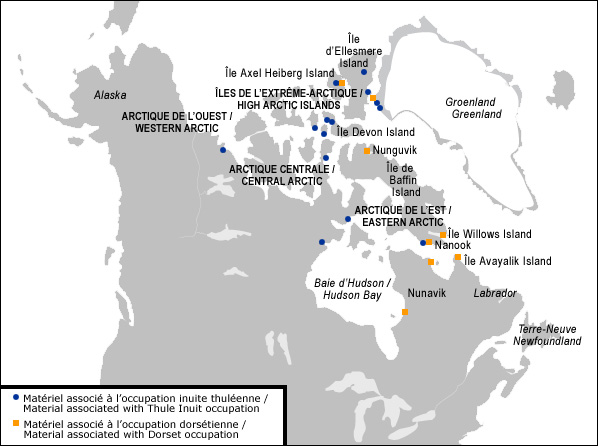
Figure 1: Locations of Norse materials associated with aboriginal sites in Arctic Canada and North Greenland.
Source: Patricia Sutherland, Canadian Museum of Civilization
In contrast, very few Dorset sites have produced Norse-related artifacts and consequently there has been little consideration given to the nature of the interaction between these two groups (Sutherland 2000). Discussion has also been hindered by the general belief that most areas of the eastern Arctic were abandoned by the Dorset people by the time the Norse colonies were established in the late tenth century AD. In this paper, new evidence will be presented to suggest that we are now at a stage where we might profitably investigate the nature of Dorset-Norse interaction.
Dorset-Norse Interactions in the Canadian Eastern Arctic – Page 2
Previously Known Finds
What is probably the evidence of earliest contact between the Dorset and the Norse is the small soapstone bowl, carved in a characteristically Dorset form, which was associated with the Norse remains at L’Anse aux Meadows (Ingstad 1977). The Dorset people had abandoned Newfoundland and southern Labrador several centuries before the arrival of the Norse in the region, and this lamp is most readily explained as an object which the Norse obtained from Dorset people or from an abandoned Dorset site in the eastern Arctic prior to a visit to the Newfoundland settlement. Since the Norse occupation at L’Anse aux Meadows probably occurred during the early eleventh century, relations between the two peoples may have begun by this time, and some of the accounts of Skraelings in the Vinland sagas may refer to Dorset people.
From a slightly later period, the Norse coin which was recovered from an Indian settlement site on the coast of Maine was minted between 1065-80, more than half a century later than the Vinland voyages recorded in Icelandic sagas. Also found at this site were artifacts of Ramah chert from northern Labrador, as well as two distinctive Dorset artifacts, suggesting that the penny passed from Norse to Dorset hands, before being traded southwards to Indian groups (Bourque and Cox 1981; Cox 1999).
Two specimens of smelted copper have been recovered from Dorset sites in the Nunavik region of the Eastern Arctic, one from a twelfth or thirteenth century Dorset site in Richmond Gulf on the eastern coast of Hudson Bay, and the other from a similar site on the coast of Ungava Bay (Harp 1975; Plumet 1982). These objects also probably reached the locations at which they were found through trade, with the initial contact between Norse and Dorset people having occurred along the eastern coasts of Baffin Island or Labrador, coasts which the Norse would have passed on visits to Vinland or Markland. The record of a ship having been storm-driven from Markland to Iceland in 1347 indicates that such voyages continued until at least the fourteenth century (Jones 1986:136).
Far to the north, a piece of smelted iron appears to be associated with the late Dorset occupation of the Buchanan Lake site on Axel Heiberg Island, on the extreme northwestern fringes of Dorset habitation (Laver 1983; Sutherland 1983). Together with the bronze pot fragment which has recently been recovered from a Late Dorset site in northwestern Greenland (Appelt et al 1998), this find suggests that contacts occurred between the Norse and Dorset people in the High Arctic, and were associated with ventures distinct from Norse voyages to Markland. In fact, it seems possible that occasional contacts may have occurred over a period of several centuries, and over a wide area of the Baffin Bay and Davis Strait coasts from Labrador to the High Arctic (Figure 1).
Dorset-Norse Interactions in the Canadian Eastern Arctic – Page 3
New Evidence from Nunguvik, Northern Baffin Island
Recently, archaeological evidence bearing on the question of Dorset/Norse interaction was found in collections which are housed at the Canadian Museum of Civilization. This evidence comes from the site of Nunguvik (PgHb-1) on Navy Board Inlet, northern Baffin Island, which was excavated in the 1970s and 1980s by Father Guy-Mary Rousselière (Figure 1).
The most significant find from this site is a three-meter length of yarn which was excavated in 1984 by Rousselière and his Inuit assistants from one of the Dorset features at Nunguvik (Figure 2). A second piece of yarn, which is probably part of the same strand, was found in another section of the feature several meters distant from the first. The specimens have been identified by Penelope Walton Rogers (1999) as plied yarn spun from the fur of Arctic hare (Lepus arcticus). The yarn also has what are most probably goat hairs attached to it, and Walton Rogers reports that it is directly comparable to yarns used in two textiles from Gården Under Sandet, the Norse farm site in the West Settlement that was excavated from 1991-1996 by the Greenland and Danish National Museums (Walton Rogers 1998). The two Greenlandic textiles, one with yarn spun exclusively from Arctic hare fur and the other with yarns spun from goat hair and the fur of Arctic hare, were recovered from deposits, dating to the last phase of occupation at Gården Under Sandet, from the end of the thirteenth century until about AD 1350 (Østergård 1998). The importance of the Nunguvik find lies in the fact that a length of spun yarn hints at a form of contact more complex than simple trade in useful objects, such as pieces of iron, copper, and bronze. Yarn would most probably have been valued only as a curiosity by Dorset people; in addition, it is more fragile than fragments of metal and unlikely to have survived a process of long-distance trade. It therefore seems reasonable to suggest that this artifact may indicate a direct visit by a Norse ship to northern Baffin Island.
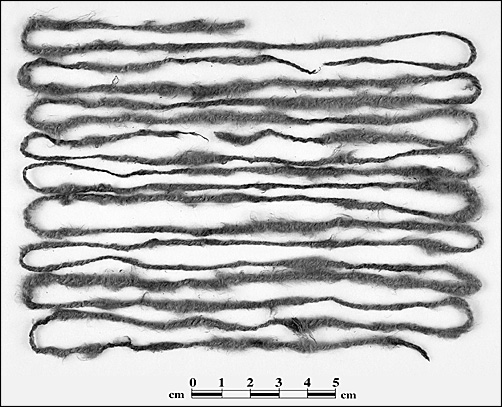
Figure 2: Yarn spun from fur of Arctic hare, from Nunguvik feature N73.
Photo: Patricia Sutherland,
Canadian Museum of Civilization
Other corroborating evidence from the same Dorset feature (N73) includes three pieces of wood identified as white pine (likely either Pinus strobus or Pinus cembra – according to the analyst, these cannot be distinguished by their wood anatomy), which does not usually occur in the Arctic as driftwood (Mott 1981). Two of the wood pieces contain iron-stained holes which appear to have been made by square nails, and one of these fragments has been radiocarbon dated to the late thirteenth or early fourteenth century (S-1615: 670+50 BP, calibrated 1 sd range AD 1286-1387, 2 sd range AD 1271-1399) (Rousselière 1991), the same period that produced the textiles woven with Arctic hare fur and goat hair in Norse Greenland (Figure 3 a).
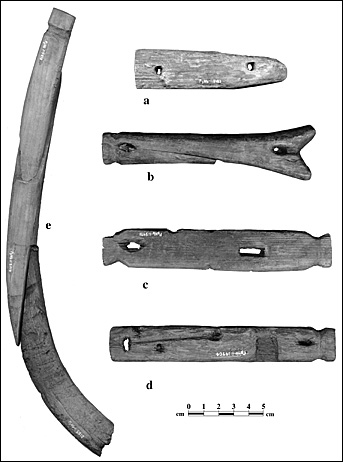
Figure 3: Unusual wooden artifacts from Nunguvik feature N73:
a. portion of pine object containing two square nail holes, b. handle-like wooden object with precise scarf, c. wooden object with rectangular mortice hole, d. handle-like wooden object with rectangular groove, e. wooden object precisely scarfed from three pieces.
Photo: Patricia Sutherland,
Canadian Museum of Civilization
Additional artifacts in the Nunguvik collection are less definitive, but may also relate to Norse contact. The assemblage from Nunguvik has always been considered unusual in the amount and variety of well preserved wooden artifacts and artifact fragments. The distinctiveness of the woodworking has generally been interpreted as simply the result of the excellent preservation conditions at the site, or perhaps exceptional access to supplies of driftwood by the local Dorset people. A closer examination of this material suggests that other factors may be at play, since much of the worked wood from Nunguvik feature N73 is outside the range of technique and style known from most other Dorset culture assemblages. These techniques include sawing, precise scarfing, the use of nails and of mortice and tenon joints, all procedures which are not characteristic of described Palaeo-Eskimo woodworking (cf. Grønnow 1994) but which do appear to resemble medieval European techniques (Figure 3 b,c,d,e). Given this similarity, it seems possible to suggest that the large amount of worked wood at this site may not be the result of exceptional access to driftwood, but to wood which reached the area by other means of transport.
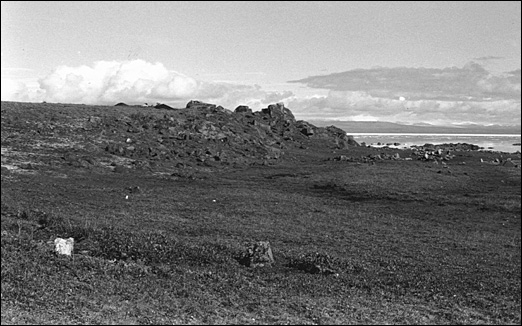
Figure 4: The site of Nunguvik, looking northwards towards the coast.
Photo: Susan Rowley
The potential significance of the yarn, the dated pine, and the other unusual worked wood from Nunguvik is dependent upon the archaeological context from which it was recovered (Figure 4). Nunguvik is situated on the west coast of Navy Board Inlet about 100 km west of the community of Pond Inlet. The site is comprised of about 80 houses belonging to Early, Middle, and Late Dorset, as well as to Early and Late Thule occupations (Rousselière 1976, 1991). Only a few of the houses have been excavated. The Dorset feature N73 is located at one edge of the site, close to the shoreline and only one or two metres above sea level. While Thule artifacts are scattered over the surface of the site of Nunguvik, there is no evidence of Thule re-use of N73. Rousselière commented on the discreteness of Dorset and Thule features at the site, and the closest Thule occupation to N73 lies on a higher terrace approximately 100 meters away. An examination of the remainder of the Nunguvik collection, excavated from other Dorset as well as Thule features, indicates that most of the unusual materials recovered from the site come from feature N73. It is a large stratified feature, comprising what appears to be a Late Dorset occupation which is intrusive into Middle Dorset deposits (Figure 5). Interpretation of the feature is complicated by the incomplete state of the field notes and maps, much of this material having perished in the fire that claimed Father Rousselière’s life and destroyed the Catholic mission in Pond Inlet in 1994. The yarn and the other unusual material appear to be associated with a midpassage feature, and occur in deeply buried stratigraphic units that contain Middle Dorset material, but also Late Dorset harpoon heads and a significant number of carvings typical of Late Dorset, albeit of a distinctly local style.
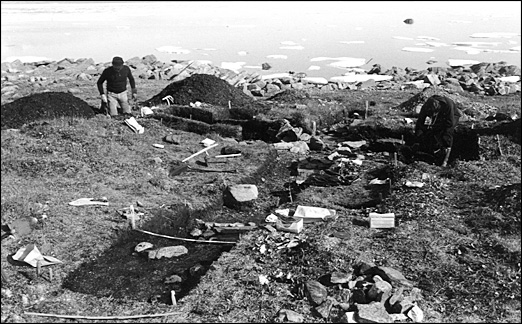
Figure 5: Nunguvik feature N73 during excavation. The yarn and unusual worked wood is from a buried layer associated with the boulder feature near the centre of the excavation.
Photo: Susan Rowley
A perplexing element of feature N73 has been the radiocarbon dates. Seven of the dates which Rousselière obtained from the complex cluster are in the sixth to eighth centuries A.D., several centuries earlier than what would be expected for a Late Dorset occupation, particularly one with associated Norse material. AMS dates were run on both pieces of yarn and on a piece of worked caribou antler which was found in close proximity to the three-meter strand. All three samples returned dates in the seventh and eighth centuries AD (Beta-135000: 1320 ±40 BP on antler, calibrated 1 sd range AD 663-762; 2 sd range AD 654-774); (Beta 134999: 1400 ±40 BP on the strand associated with the antler, calibrated 1 sd range AD 616-665, 2 sd range AD 567-689); and (Beta-139756: 1290 ±40 BP on the smaller piece of yarn, calibrated 1 sd range AD 682-770; 2sd range AD 656-858). Results on the three samples are within the range of the cluster of seven dates previously recovered from the feature. The date on the worked piece of white pine is evidence in support of a medieval component of the feature, and is in accord with the similarity of the yarn to that in Norse textiles of the late thirteenth/early fourteenth centuries. The discrepancy between this evidence and the early radiometric measurements on the yarn is a significant problem which needs to be addressed in future research.
Dorset-Norse Interactions in the Canadian Eastern Arctic – Page 4
Dorset Wands and Other European-like Face Images
Other archaeological specimens which might bear closer examination in light of the findings from Nunguvik are the Late Dorset carvings with occasional representations of European-like faces. These images have long been noted, but their interpretations as evidence of contact have generally been discarded as based on judgements which are only subjective. Batons or wands displaying a wide range of images are found on late Dorset sites throughout the eastern Arctic. On a number of these specimens, a distinctive long and narrow face with a prominent straight nose and occasional hints of a beard appear (Figure 6 a,b). It is interesting to note that several of these images were found in N73 at Nunguvik (Figure 6 c,d). Perhaps it is time to re-evaluate the significance of the wands and other Late Dorset specimens where these types of images occur.
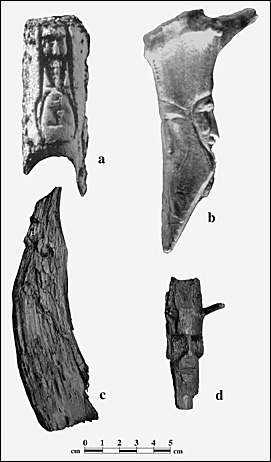
Photo: Patricia Sutherland Figure 6: Dorset representations of European-like faces:
a. antler wand from TaJa-1, the Battery site, Axel Heiberg Island, showing a narrow and possibly bearded face (upright) opposed to a more typical Dorset depiction of a human face, b. antler wand from QiLd-1, the Brooman Point site, Bathurst Island, showing a long-nosed face in right profile, c. wooden carving from Nunguvik N73, northern Baffin Island, showing a long-nosed face with prominent eyebrows in left profile, d. wooden carving from Nunguvik N73, northern Baffin Island, showing a long-nosed face; the apparent “horns” are twigs which are part of the original piece of wood.
Photo: Patricia Sutherland,
Canadian Museum of Civilization
Dorset-Norse Interactions in the Canadian Eastern Arctic – Page 5
Late Dorset in the Eastern High Arctic
What is the probability that more extensive contact occurred between Norse and Dorset peoples than has been indicated by the evidence currently available? If one accepts the argument proposed by Park (1993) regarding the disappearance of Dorset occupation by the tenth century A.D., no opportunity for contact between the Dorset and the Greenlandic Norse would have been possible. However, a growing number of radiocarbon dates associated with Late Dorset components in the High Arctic (Figure 7 a) suggests the continuance of Dorset occupation into the mediaeval period. If only one of these dates is accepted as being correct, it provides evidence of a significant temporal opportunity for contact with the Greenlandic Norse. It is also interesting to compare this range of dates with those from Thule culture in the same area (Figure 7 b). These distributions show essentially the same overlapping range of dates, and suggest that both populations had roughly the same degree of opportunity for meetings with early European occupants of Greenland.
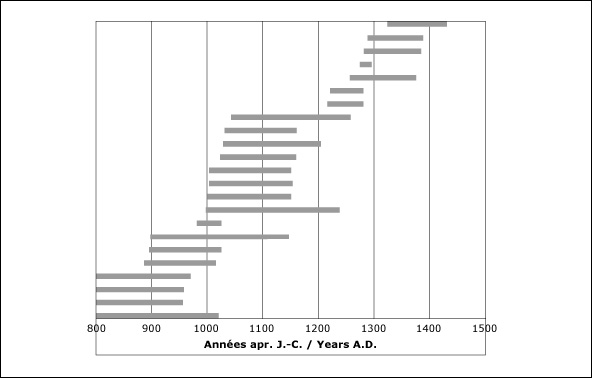
Figure 7a: Radiocarbon dates on High Arctic Late Dorset components: 1 sd ranges of calibrated dates.
Source: Patricia Sutherland, Canadian Museum of Civilization
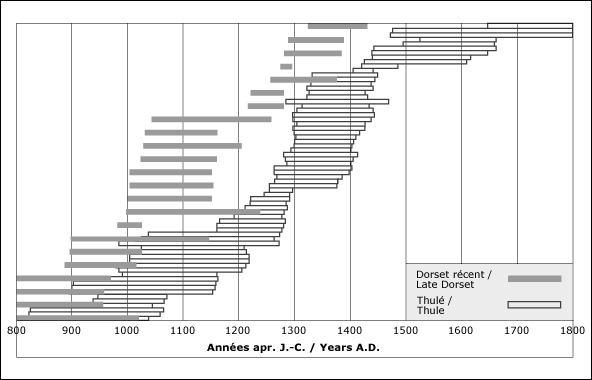
Figure 7b: Radiocarbon dates on High Arctic Thule and Late Dorset components: 1 sd ranges of calibrated dates.
Source: Patricia Sutherland, Canadian Museum of Civilization
In order to provide a general estimate of the extent of our knowledge of Late Dorset culture in the High Arctic, the results of a 800 km survey undertaken several years ago along the southern coast of Devon Island have been examined (Sutherland 1991). On the basis of extrapolation from the number of sites and features discovered during this survey, we can estimate that there may be on the order of 2000 Late Dorset occupation features in High Arctic Canada. Less than 20 of these features have currently been excavated, so that our excavated sample is most likely smaller than 1% of the total number of features occupied during the centuries when the Dorset and Norse people may have been in contact. On the basis of a sample of this size, the fact that we have recovered Norse material from three structures in the High Arctic suggests that contact may have occurred more frequently than we have previously suspected.
Dorset-Norse Interactions in the Canadian Eastern Arctic – Page 6
Conclusions
The strands of yarn and the wood recognized in the collections from Nunguvik, as well as smelted metal recently recovered from Late Dorset sites in other regions, has led to the consideration of new possibilities regarding the nature of relations between the Dorset people and the Norse. The yarn also provides evidence supporting the view that Dorset people survived in the High Arctic for some time after the arrival of the Norse in Greenland, and the similarity of the Nunguvik yarn to that used in late thirteenth/early fourteenth century textiles from Gården Under Sandet suggests Dorset survival into the fourteenth century.
What do the new finds tell us about the nature of Dorset-Norse contact? For the reasons argued previously, it is suggested that the strands of yarn from Nunguvik may be more indicative of direct contact on Baffin Island than long distance trade from a more geographically removed episode of contact. If such contact did occur in this local region, did it perhaps have more influence on local Dorset culture than we have perceived in the better-documented cases of Norse-Inuit contact? The answer to this question may lie in the unusual assemblage of wooden artifacts from feature N73. If this material does prove to resemble Norse workmanship as much as, or more than, it does Dorset workmanship, we may have to begin thinking in much different terms regarding the nature of Norse contact and influence on the aboriginal occupants of the High Arctic.
Dorset-Norse Interactions in the Canadian Eastern Arctic – Page 7
Addendum
While preparing the final copy of this paper, further evidence was found in the Canadian Museum of Civilization’s collections from two sites on southern Baffin Island, over 1000 kilometers from Nunguvik (Figure 1). Yarn or string, supposedly twisted from muskox wool, had been reported from the Nanook site (KdDq-9) and the nearby Tanfield site (KdDq-7) located close to Kimmirut (formerly Lake Harbour) on the southern coast of Baffin Island (Maxwell 1973). Samples of the yarn from Nanook were recently identified as being spun from Arctic hare fur, and plied like the yarn from Nunguvik (Walton Rogers 2000) (Figure 8 c). The collections from Nanook and Tanfield also include unusual wooden artifacts (Figure 8 a) and a considerable amount of wood debris which, interestingly, Maxwell described as of good quality and suggesting that “the wood may have been imported from the south rather than collected through the vagaries of wind and current” (1973: 228). Examination of the wood assemblage shows that it bears a close similarity to that from Nunguvik. One of the wooden fragments recently re-examined in the collection from Nanook (Figure 8 b) has a cut geometric design on one surface which is not typical of Dorset, but which does resemble decoration on Norse artifacts (see Norlund and Stenberger 1934: Figure 101 (c) and Roussell 1936: Figure 103 (1)). While the Nanook site was assigned to a Middle Dorset period on the basis of stylistic comparisons and numerous radiocarbon dates (Maxwell 1973, 1976), a single radiocarbon date on willow twigs yielded an assay of 580 ±80 BP (GAK-1288: calibrated 1 sd range AD 1306-1414, 2 sd range AD 1279-1451). The material on which the date was obtained appears to derive from a locality and depth which place it in relatively close association with the yarn, and the age is similar to the date on the worked pine sample from Nunguvik N73.
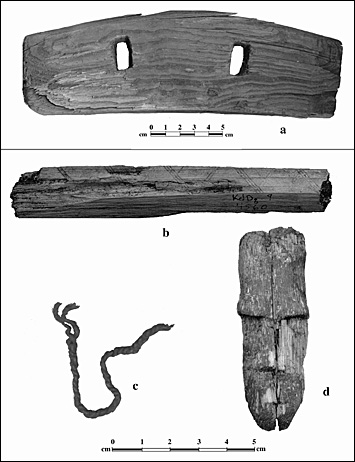
Figure 8: Yarn and wooden artifacts from the Nanook site (KdDq-9), southern Baffin Island:
a. flat plank with rectangular mortice holes, b. portion of a wooden artifact with cut geometrical design on upper face, c. yarn spun from fur of Arctic hare, d. maskette depicting a narrow long-nosed face with prominent eyebrows and what may be headgear; the nose and mouth area are damaged.
Photo: Patricia Sutherland,
Canadian Museum of Civilization
In addition to the yarn and the unusual worked wood, the Nanook site produced a small wooden maskette (Figure 8d), from which most of the nose is missing due to damage. Although the specimen is in a Dorset style, it depicts a long and possibly bearded face distinguished by straight and very pronounced eyebrows, and what may be headgear similar to that shown in other depictions of individuals who appear to be Norse (Gulløv 1983).
Yarn was also reported from an undated stratum at the Willows Island 4 site (KeDe-14) in Frobisher Bay, southeastern Baffin Island (Figure 1), excavated by Daniel Odess in 1992 and 1993 (Odess 1996, 1998). This has been recently identified as spun and plied yarn from Arctic hare fur (Walton Rogers 2000). Willows Island 4 also contains a large sample of worked wood which is outside the general range of style and technique known from other Dorset assemblages, but similar to that from Nunguvik and Nanook. The site is assigned to an Early/Middle Dorset period on the basis of artifact styles and radiocarbon dates (Odess 1998).
Supposed muskox wool cordage has been reported from a fourth assemblage, from the Avayalik Island 1 site (JaDb-10) in northern Labrador which was excavated by Richard Jordan in 1978 (Jordan 1980). The Avayalik Island 1 site comprises both Middle and Late Dorset components, the latter dated by one radiocarbon measurement of 670 ±60 BP (SI-3864: calibrated 1 sd range AD 1284-1390, 2 sd range 1255-1408) on conifer wood. The cordage is associated with the Middle Dorset component, as is a large and unusual worked wood assemblage. Plans for examining this material are currently underway.
The interpretation that the yarn and unusual wood assemblages from these sites is related to contact with Norse Greenlanders is at apparent variance with the assessed ages of the associated Dorset culture assemblages. The material from Nanook and Tanfield, Willows Island 4, and possibly that from Avayalik Island 1, as well as Nunguvik, are all associated with Dorset culture assemblages which have been assigned by their excavators to Early or Middle Dorset periods. If one accepts the mid-first millennium AD age assignment of the yarn from Nunguvik and the age assignments on the relevant components of the other Baffin Island sites, and if one believes that spinning was not an indigenous technique that was used in Arctic North America, then one must consider the possibility, remote as it may seem, that these finds may represent evidence of contact with Europeans prior to the Norse arrival in Greenland. Currently, the most reasonable interpretation would be to assume that problems exist with radiocarbon dating and artifact provenience, and that the European association of this material relates to mediaeval Norse Greenland. Hopefully, new archaeological research and a closer examination of the problems involved with Arctic radiocarbon dates and their usage (cf. Park 1993, McGhee 2000) will provide us with an answer to the current discrepancies in interpretation.
In view of these recent discoveries, the conclusions presented in this paper should be amended to suggest that contact between the Dorset people and the Norse (or possibly some other earlier visitors) may have occurred over a broad region of the Eastern Arctic coasts, and this contact may have been more complex and intensive than has previously been considered.
Dorset-Norse Interactions in the Canadian Eastern Arctic – Page 8
Acknowledgements
I would like to thank Martin Appelt, Jette Arneborg, and Hans Christian Gulløv from the Danish National Museum for the invitation to participate in the conference and for making archaeological collections accessible to me during that time. I would also like to express my appreciation to Else Østergård and Paul Grinder Hanson at the Danish National Museum for taking time to show me the Greenlandic Norse textile and wood collections while I was in Copenhagen. I want to thank Penelope Walton Rogers from Textile Research in Archaeology in York, England who identified the yarns and answered many questions. I would like to acknowledge Daniel Odess at the Smithsonian Institution who suggested that I examine the yarn from the Willows Island 4 collection which he excavated as part of his doctoral research. The Canadian Museum of Civilization provided support for some of the research that was done in preparation for this paper, and I would like to thank a number of individuals working at the museum. Stacey Girling-Christie and Tim Panas from Collections Management Services have provided countless hours of assistance, as has my student volunteer, Lindsay Paterson. I would also like to express my appreciation to Julie Hughes and Carolyn Marchand from Conservation and Technical Services, Sarah Prower and Ann Rae from Collections Management Services, and Sylvie Ledoux from the Archaeological Survey of Canada. The Canadian Archaeological Radiocarbon data base compiled by Richard Morlan from the Archaeological Survey of Canada has been an invaluable tool in preparing this paper and I want to acknowledge Dick for his efforts. Finally, for the interest they have shown and the knowledge they have shared, I wish to thank Jacques Cinq-Mars, Robert McGhee, and David Morrison from the Archaeological Survey of Canada.
Dorset-Norse Interactions in the Canadian Eastern Arctic – Page 9
References
1998
Appelt, Martin, Hans Christian Gulløv and Hans Kapel
1996
Arneborg, Jette
1981
Bourque, Bruce J., and Steven L. Cox
1999
Cox, Steven L.
1983
Gulløv, Hans Christian
1997
1994
Grønnow, Bjarne
1975
Harp, Elmer Jr.
1944
Holtved, Erik
1977
Ingstad, Anne Stine
1986
Jones, Gwyn
1980
Jordan, Richard
1983
Laver, Marilyn
1973
Maxwell, M.S.
1976 Pre-Dorset and Dorset Artifacts: the View from Lake Harbour. In Eastern Arctic Prehistory: Paleoeskimo Problems, pp. 58-78. Edited by M.S. Maxwell, Memoirs of the Society for American Archaeology 31.
1984
McGhee, Robert
2000 The Nature and Timing of the Thule Migration. In Identities and Cultural Contacts in the Arctic: Proceedings from a Conference at the Danish National Museum, Copenhagen, November 30 to December 2, 1999. Edited by Martin Appelt, Joel Berglund and Hans Christian Gulløv, Danish National Museum & Danish Polar Center, Copenhagen.
1981
Mott, Robert
1934
Norlund, Poul and Marten Stenberger
1996
Odess, Daniel
1998 The Archaeology of Interaction: Views from Artifact Style and Material Exchange in Dorset Society. American Antiquity 63 (3): 417-435.
1998
Østergård, Else
1993
Park, Robert
1982
Plumet, Patrick
1936
Roussell, Aage
1976
Rousselière, Guy-Mary
1991
1978
Sabo, Deborah, and George Sabo
1980
Schledermann, Peter
1993 Norsemen in the High Arctic? In Viking Voyages to North America, pp. 54-66. Edited by B. Laursen. Viking Ship Museum, Roskilde.
1983
Sutherland, Patricia D.
1991
1993
2000 The Norse and Native North Americans. In Vikings: The North Atlantic Saga. Edited by William W. Fitzhugh and Elisabeth I. Ward, pp. 238-247. Smithsonian Institution Press, Washington, D.C.
1983
Sutherland, Patricia D. and Robert McGhee
1998
Walton Rogers, Penelope
1999 A Plied Yarn from Nunguvik, Baffin Island, PgHb-1:14765. Manuscript report on file, Archaeological Survey of Canada, Canadian Museum of Civilization, Hull, Québec. 2 pp.